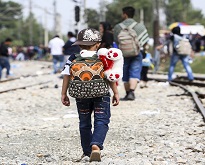In 2016, over 12 million children around the world were living as refugees or asylum seekers, while an estimated 23 million children were internally displaced – 16 million by conflict and 7 million by natural disasters. Yet the real number of children driven from their homes remains unknown and is likely to be significantly higher than the estimate because of gaps in reporting and data.
In ‘A call to action: Protecting children on the move starts with better data’, UNICEF, UNHCR, IOM, Eurostat and OECD together highlight the crucial role of data in understanding the patterns of global migration.
The Call to Action confirms alarming holes in the availability, reliability, timeliness and accessibility of data and evidence, for example:
- Information on age is recorded for just 56 per cent of the global refugee population;
- Only 20 per cent of countries or territories with data on conflict-related internally displaced persons (IDP) make a breakdown by age;
- Nearly a quarter of countries and territories do not have age-disaggregated data on migrants, including 43 per cent of countries in Africa; and
- Lack of information on migrant and displaced children deprives the affected children of the protection and services they need.
UNICEF, UNHCR, IOM, Eurostat and OECD urge countries to address the data and evidence gaps pertaining to children on the move by doing the following:
- Disaggregating data by age and sex;
- Covering key issues relating to children affected by migration and displacement;
- Making better use of, and sharing, existing data;
- Coordinating data efforts within countries and across borders;
- Making special efforts to collect and analyse data on children.
More information:
A call to action: Protecting children on the move starts with better data here
Joint press release by UNICEF, UNHCR, IOM, Eurostat and OECD here
Dedicated Eurostat website section on asylum and managed migration here
Dedicated Eurostat website section on migrant integration here
Dedicated Eurostat data tables on Migrant children can be found under the cross-cutting topic ‘Indicators on migrants and migrant integration’ in Eurostat database here

